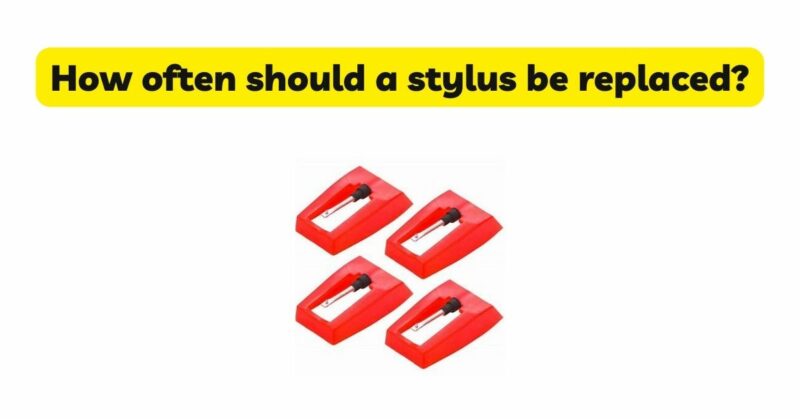The stylus is a critical component of a record player, responsible for translating the grooves on vinyl records into the beautiful sounds we cherish. Like any other component, styluses have a finite lifespan and require periodic replacement to ensure optimal performance and sound quality. In this article, we will explore the factors that influence stylus wear, signs indicating the need for replacement, and guidelines for determining how often a stylus should be replaced.
- Understanding Stylus Wear: Stylus wear is a natural process that occurs over time due to the interaction between the stylus tip and the record grooves. Several factors influence the rate of stylus wear, including record quality, tracking force, usage patterns, and maintenance practices. It is important to be aware of these factors to gauge the lifespan of your stylus accurately.
- Record Quality and Maintenance: The condition and quality of the vinyl records being played significantly impact stylus wear. Well-maintained, clean records with minimal defects and debris reduce the stress on the stylus and can prolong its lifespan. On the other hand, records with deep scratches, dirt, or dust particles can cause accelerated wear and compromise both the stylus and sound quality.
- Tracking Force: The tracking force, or the downward pressure exerted by the stylus on the record, plays a crucial role in stylus wear. Insufficient tracking force can cause the stylus to skip or mistrack, leading to increased wear on specific areas of the stylus tip. Conversely, excessive tracking force can exert unnecessary pressure on the stylus and the record, resulting in accelerated wear. Following the manufacturer’s recommended tracking force range ensures optimal stylus performance and minimizes wear.
- Usage Patterns: The frequency and duration of usage directly impact the lifespan of a stylus. Heavy and prolonged use, such as DJing or continuous playback, can cause faster wear compared to moderate or occasional use. Understanding your usage patterns and considering the demands placed on the stylus during playback will provide insights into the replacement interval.
- Signs Indicating the Need for Replacement: While stylus wear is inevitable, there are several signs that indicate the need for stylus replacement:
a. Sound Quality: A noticeable deterioration in sound quality is often the most apparent sign of stylus wear. The music may sound dull, lacking clarity, dynamics, or high-frequency response. If your records no longer sound as vibrant or detailed as before, it is likely a sign that the stylus needs replacing.
b. Surface Noise and Distortion: Increased surface noise, pops, clicks, or distortion during playback can be indicative of a worn stylus. As the stylus tip wears down, it may struggle to maintain proper contact with the record grooves, resulting in compromised sound reproduction and an overall degraded listening experience.
c. Visual Inspection: Regularly inspecting the stylus under a magnifying glass or microscope can provide insights into its condition. Look for signs of wear, such as a flattened or chipped diamond tip, uneven wear patterns, or visible damage. These visual cues can confirm the need for stylus replacement.
d. Tracking Issues: Tracking problems, such as excessive skipping, mistracking, or erratic movement across the record, can be a clear indication of stylus wear. If the stylus is unable to properly track the grooves, it can result in distorted sound and potential damage to both the stylus and the record.
- Manufacturer Recommendations and Guidelines: Stylus replacement intervals can vary depending on factors such as usage, record quality, and maintenance practices. However, manufacturers often provide guidelines and recommendations regarding stylus replacement intervals for their specific models. It is advisable to consult the manufacturer’s documentation or contact their customer support to obtain accurate information regarding the expected lifespan of your stylus.
- Usage and Listening Habits: Individual listening habits and patterns should also be considered when determining how often to replace the stylus. If you are a frequent listener or engage in DJing or other demanding activities, the stylus may experience faster wear. Similarly, prolonged sessions or continuous playback can contribute to increased wear. Assessing your usage patterns and listening habits will help in establishing a suitable replacement schedule.
- Regular Maintenance and Care: Proper maintenance and care can extend the lifespan of a stylus. Regularly cleaning the stylus with appropriate tools, keeping the records clean and free from debris, and ensuring proper alignment and tracking force are essential practices for minimizing wear. By adopting these maintenance measures, you can optimize stylus performance and potentially extend the replacement interval.
- Consultation with Experts: For those seeking professional guidance or audiophile enthusiasts aiming for the highest level of accuracy, consulting with experts in the field can provide valuable insights. Professional turntable setup services or audio equipment specialists can offer personalized recommendations based on your specific setup, usage, and listening preferences.
- Conclusion: Determining how often a stylus should be replaced depends on various factors such as record quality, tracking force, usage patterns, and maintenance practices. While there are general guidelines and manufacturer recommendations, it is essential to pay attention to signs of stylus wear, including sound degradation, surface noise, tracking issues, and visual cues. Regular inspection and maintenance, combined with an understanding of your listening habits, will help you establish a suitable replacement interval for your stylus. By proactively replacing a worn stylus, you can ensure optimal sound quality and preserve the longevity of both your records and your audio equipment.

